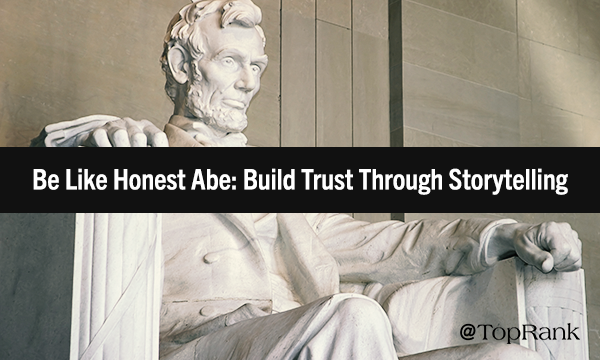Be Like Honest Abe: How Content Marketers Can Build Trust Through Storytelling

 Pardon me for telling the same old story once again ... Storytelling is a fundamental staple of content marketing. This isn’t news. It has become a central talking point throughout the business world, and one we’ve discussed quite frequently here on the TopRank Marketing Blog. Compelling narrative is impactful for fairly obvious reasons: it captivates a reader, keeps them engaged, and tends to leave a lasting impression. The psychological power of storytelling has endured from ancient times, and outweighs any new technology or tactic that comes along. But one of the less-discussed benefits of storytelling might be among the most important in today’s context: it builds trust with your customers and prospects. Today, we’ll examine how this dynamic works and why every marketer should be on board.
Pardon me for telling the same old story once again ... Storytelling is a fundamental staple of content marketing. This isn’t news. It has become a central talking point throughout the business world, and one we’ve discussed quite frequently here on the TopRank Marketing Blog. Compelling narrative is impactful for fairly obvious reasons: it captivates a reader, keeps them engaged, and tends to leave a lasting impression. The psychological power of storytelling has endured from ancient times, and outweighs any new technology or tactic that comes along. But one of the less-discussed benefits of storytelling might be among the most important in today’s context: it builds trust with your customers and prospects. Today, we’ll examine how this dynamic works and why every marketer should be on board.
Storytelling Was Abraham Lincoln’s Greatest Strength
 “Four score and seven years ago…” With these six words, Abraham Lincoln launched the Gettysburg Address, one of the most famous speeches in American history. He set up a persuasive argument in favor of human equality by calling to mind the nation’s origins, and the principles that formed its foundation. Last year at Quartz, Dacher Keltner wrote about how good leaders tell stories that make people trust them with power, citing Lincoln as a prime example. Keltner suggested that the 16th president’s “ability to shape moving narratives about the Civil War and the organizing principles of the United States was … crucial to navigating the fractious politics of his presidency.” Modern marketers are not tasked with bridging a divided country, but we do face an uphill battle in this crowded, fractured digital setting. And with trust toward media, organizations and institutions diminishing, stories present an underrated vehicle for fostering connections and establishing credibility. Lisa Saffran, who teaches Storytelling in Public Health at the University of Missouri, explains that storytelling injects an element of humanity, which might be particularly helpful for B2B companies:
“Four score and seven years ago…” With these six words, Abraham Lincoln launched the Gettysburg Address, one of the most famous speeches in American history. He set up a persuasive argument in favor of human equality by calling to mind the nation’s origins, and the principles that formed its foundation. Last year at Quartz, Dacher Keltner wrote about how good leaders tell stories that make people trust them with power, citing Lincoln as a prime example. Keltner suggested that the 16th president’s “ability to shape moving narratives about the Civil War and the organizing principles of the United States was … crucial to navigating the fractious politics of his presidency.” Modern marketers are not tasked with bridging a divided country, but we do face an uphill battle in this crowded, fractured digital setting. And with trust toward media, organizations and institutions diminishing, stories present an underrated vehicle for fostering connections and establishing credibility. Lisa Saffran, who teaches Storytelling in Public Health at the University of Missouri, explains that storytelling injects an element of humanity, which might be particularly helpful for B2B companies:
“Human beings are primed to tell stories but also to listen for the person behind a story being told. Storytelling, whether it’s reporting the news or writing a memoir, involves the active selection and ordering of some information and the omission of other information. Principles of selection inform what questions we ask and which answers we might receive. This directing, ordering and selecting reflects a human consciousness at work, a person with beliefs, assumptions and suspicions.”Everywhere you look, the tactic is becoming more ingrained. [bctt tweet="With trust toward media, organizations and institutions diminishing, stories present an underrated vehicle for fostering connections and establishing credibility. - NickNelsonMN #ContentMarketing #Storytelling" username="toprank"]
Stories Are Growing More Ubiquitous
Every content creator should consider themself a storyteller. When we write, we are invariably sharing a story: about our solution, about our customers, about the pains we can help solve. And the integration of narrative is extending beyond marketing copy. Sales professionals are incorporating stories into their presentations and pitches. Companies use stories to attract quality talent. The video marketing movement is largely driven by storytelling and its innate resonance, reflected by the rapid growth of ‘Stories’ on social media platforms. When people hear or see stories, their brains light up in different ways, tapping both the rational and emotional areas. Tying multiple pieces of information together in a coherent, chronological, and — above all — relatable way makes the message far more affecting. The content suddenly becomes experiential instead of merely educational. It’s also what an audience craves. As Rachel Gillett wrote for Fast Company:“Our brains are insanely greedy for stories. We spend about a third of our lives daydreaming–our minds are constantly looking for distractions — and the only time we stop flitting from daydream to daydream is when we have a good story in front of us.”We can satiate this appetite by putting a good story in front of the people we want to reach. But it’s not that simple. When it comes to building influence through storytelling, there are a few considerations worth keeping front-and-center. [bctt tweet="Tying multiple pieces of info together in a coherent, chronological, & relatable way makes the message far more affecting. The content suddenly becomes experiential instead of merely educational. - @NickNelsonMN #ContentMarketing #Storytelling" username="toprank"]
How to Maximize Storytelling as a Trust-Building Tool
Stories serve many purposes in marketing. In our current environment, building trust may be the most vital among them. If this is the goal, make sure you adhere to these imperatives.#1 - Be Genuine, Authentic, and Transparent
Lincoln didn’t gain the nickname “Honest Abe” for nothing. Despite his physique, the gangly 6-foot-4 politician didn’t have a reputation for spinning tall tales (at least not in misleading ways). Storytelling backfires when it strikes people as false or disingenuous. Share real anecdotes and back them with third-party evidence or quotes. Telling hard truths, even if it means acknowledging a shortcoming in your business, can be tremendously beneficial in the long run. Even more than being true to the facts, you must be true to yourself, and your brand. In his book, All Marketers are Liars, Seth Godin lays this out this first tenet of telling a great story:“A great story is true. Not true because it’s factual, but because it’s consistent and authentic. Consumers are too good at sniffing out inconsistencies for a marketer to get away with a story that’s just slapped on.”[bctt tweet="A great story is true. Not true because it’s factual, but because it’s consistent and authentic. - @ThisIsSethsBlog #ContentMarketing #Storytelling " username="toprank"]
#2 - Make It Meaningful to Your Audience
You know who you’re trying to reach. Hopefully you know a fair amount about them and their circumstances. When crafting a story, you must ask yourself if there’s a relevant hook that will make it applicable for them personally. As Ashley Zeckman has written here in the past: “Your customers should be able to see themselves in the story that you are telling through content.” This dynamic makes case studies, customer testimonials, and content featuring industry thought leaders and influencers — featuring first-person perspectives from businesses very similar to the ones you target as prospects — tremendously powerful. But even beyond that, it’s crucial to outline situations, scenarios, and challenges that your audience can relate to. Empathy is essential to gaining trust. [bctt tweet="Your customers should be able to see themselves in the story that you are telling through content. - @azeckman #ContentMarketing #Storytelling" username="toprank"]#3 - Implement Recurring Themes
As you can tell from the opening sentence of this post, and many of the links scattered throughout, this is not the first time we’ve discussed storytelling on this blog. But we only continue to focus on it because of its critical importance in content marketing today. And hopefully this ongoing emphasis helps crystallize this significance. There’s an actual psychological phenomenon behind this: our brains give preference to the familiar. Once a seed or idea has been planted through effective and memorable narrative, people are more likely to notice and internalize it going forward. In other words, telling the “same old story” isn’t such a bad thing, so long as you can find new angles and dimensions to explore. A robust, ongoing, expanding narrative has the capability to continually reinforce trust and confidence. [bctt tweet="Telling the “same old story” isn’t such a bad thing, so long as you can find new angles and dimensions to explore. - NickNelsonMN #ContentMarketing #Storytelling" username="toprank"]What’s Your Story?
via GIPHY As you contemplate your brand narrative and how you’ll present it going forward, I encourage you to keep these three cornerstones in mind: authenticity, relevance, and familiarity. When storytelling incorporates all three elements successfully, it can build trust in ways unparalleled by other methods. Storytelling can not only build trust, but also influence with your audience. Check out our post Cracking the Code: 3 Steps to Building Influence with Content Marketing for actionable tips and insights. At TopRank Marketing, storytelling is a core component of our content marketing approach. Give us a shout if you’d like to hear the whole story.The post Be Like Honest Abe: How Content Marketers Can Build Trust Through Storytelling appeared first on Online Marketing Blog - TopRank®.
Share from Online Marketing Blog – TopRank®
Be Like Honest Abe: How Content Marketers Can Build Trust Through Storytelling
 Reviewed by mimisabreena
on
Monday, May 28, 2018
Rating:
Reviewed by mimisabreena
on
Monday, May 28, 2018
Rating:
 Reviewed by mimisabreena
on
Monday, May 28, 2018
Rating:
Reviewed by mimisabreena
on
Monday, May 28, 2018
Rating:

















No comments:
Post a Comment